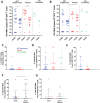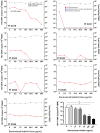Increased HIV-1 transcriptional activity and infectious burden in peripheral blood and gut-associated CD4+ T cells expressing CD30
- PMID: 29470552
- PMCID: PMC5823470
- DOI: 10.1371/journal.ppat.1006856
Increased HIV-1 transcriptional activity and infectious burden in peripheral blood and gut-associated CD4+ T cells expressing CD30
Abstract
HIV-1-infected cells persist indefinitely despite the use of combination antiretroviral therapy (ART), and novel therapeutic strategies to target and purge residual infected cells in individuals on ART are urgently needed. Here, we demonstrate that CD4+ T cell-associated HIV-1 RNA is often highly enriched in cells expressing CD30, and that cells expressing this marker considerably contribute to the total pool of transcriptionally active CD4+ lymphocytes in individuals on suppressive ART. Using in situ RNA hybridization studies, we show co-localization of CD30 with HIV-1 transcriptional activity in gut-associated lymphoid tissues. We also demonstrate that ex vivo treatment with brentuximab vedotin, an antibody-drug conjugate (ADC) that targets CD30, significantly reduces the total amount of HIV-1 DNA in peripheral blood mononuclear cells obtained from infected, ART-suppressed individuals. Finally, we observed that an HIV-1-infected individual, who received repeated brentuximab vedotin infusions for lymphoma, had no detectable virus in peripheral blood mononuclear cells. Overall, CD30 may be a marker of residual, transcriptionally active HIV-1 infected cells in the setting of suppressive ART. Given that CD30 is only expressed on a small number of total mononuclear cells, it is a potential therapeutic target of persistent HIV-1 infection.
Conflict of interest statement
The authors have declared that no competing interests exist.
Figures





Similar articles
-
Virological and immunological responses to raltegravir and dolutegravir in the gut-associated lymphoid tissue of HIV-infected men and women.Antivir Ther. 2018;23(6):495-504. doi: 10.3851/IMP3236. Antivir Ther. 2018. PMID: 29714167 Free PMC article. Clinical Trial.
-
Circulating CD30+CD4+ T Cells Increase Before Human Immunodeficiency Virus Rebound After Analytical Antiretroviral Treatment Interruption.J Infect Dis. 2020 Mar 16;221(7):1146-1155. doi: 10.1093/infdis/jiz572. J Infect Dis. 2020. PMID: 31677350 Free PMC article.
-
In vivo analysis of the effect of panobinostat on cell-associated HIV RNA and DNA levels and latent HIV infection.Retrovirology. 2016 May 21;13(1):36. doi: 10.1186/s12977-016-0268-7. Retrovirology. 2016. PMID: 27206407 Free PMC article.
-
CD30: from basic research to cancer therapy.Immunol Res. 2013 Dec;57(1-3):151-8. doi: 10.1007/s12026-013-8464-1. Immunol Res. 2013. PMID: 24233555 Free PMC article. Review.
-
HIV-1 in peripheral blood monocytes: an underrated viral source.J Antimicrob Chemother. 2002 Sep;50(3):309-11. doi: 10.1093/jac/dkf143. J Antimicrob Chemother. 2002. PMID: 12205054 Review. No abstract available.
Cited by
-
Why and where an HIV cure is needed and how it might be achieved.Nature. 2019 Dec;576(7787):397-405. doi: 10.1038/s41586-019-1841-8. Epub 2019 Dec 18. Nature. 2019. PMID: 31853080 Free PMC article. Review.
-
Key Players in HIV-1 Transcriptional Regulation: Targets for a Functional Cure.Viruses. 2020 May 11;12(5):529. doi: 10.3390/v12050529. Viruses. 2020. PMID: 32403278 Free PMC article. Review.
-
Highlights of the 9th edition of the Conference on HIV Persistence During Therapy, 10-13 December 2019, Miami, USA.J Virus Erad. 2020 Apr 30;6(2):85-95. doi: 10.1016/S2055-6640(20)30022-4. J Virus Erad. 2020. PMID: 32405427 Free PMC article. No abstract available.
-
The Biology of the HIV-1 Latent Reservoir and Implications for Cure Strategies.Cell Host Microbe. 2020 Apr 8;27(4):519-530. doi: 10.1016/j.chom.2020.03.014. Cell Host Microbe. 2020. PMID: 32272077 Free PMC article. Review.
-
Single cell spatial profiling of FFPE splenic tissue from a humanized mouse model of HIV infection.Biomark Res. 2024 Oct 8;12(1):116. doi: 10.1186/s40364-024-00658-x. Biomark Res. 2024. PMID: 39380117 Free PMC article.
References
-
- Stein H, Mason DY, Gerdes J, O'Connor N, Wainscoat J, et al. (1985) The expression of the Hodgkin's disease associated antigen Ki-1 in reactive and neoplastic lymphoid tissue: evidence that Reed-Sternberg cells and histiocytic malignancies are derived from activated lymphoid cells. Blood 66: 848–858. - PubMed
-
- Falini B, Pileri S, Pizzolo G, Durkop H, Flenghi L, et al. (1995) CD30 (Ki-1) molecule: a new cytokine receptor of the tumor necrosis factor receptor superfamily as a tool for diagnosis and immunotherapy. Blood 85: 1–14. - PubMed
-
- Chiarle R, Podda A, Prolla G, Gong J, Thorbecke GJ, et al. (1999) CD30 in normal and neoplastic cells. Clin Immunol 90: 157–164. doi: 10.1006/clim.1998.4636 - DOI - PubMed
-
- Biswas P, Mantelli B, Delfanti F, Ferrarini M, Poli G, et al. (2003) CD30 ligation differentially affects CXCR4-dependent HIV-1 replication and soluble CD30 secretion in non-Hodgkin cell lines and in gamma delta T lymphocytes. Eur J Immunol 33: 3136–3145. doi: 10.1002/eji.200324344 - DOI - PubMed
-
- Biswas P, Smith CA, Goletti D, Hardy EC, Jackson RW, et al. (1995) Cross-linking of CD30 induces HIV expression in chronically infected T cells. Immunity 2: 587–596. - PubMed
Publication types
MeSH terms
Substances
Grants and funding
- R33 AI116205/AI/NIAID NIH HHS/United States
- U19 AI096109/AI/NIAID NIH HHS/United States
- K24 AI069994/AI/NIAID NIH HHS/United States
- R21AI116205 /NH/NIH HHS/United States
- K01 HL140804/HL/NHLBI NIH HHS/United States
- R21 AI116205/AI/NIAID NIH HHS/United States
- HHSN272201400002C/AI/NIAID NIH HHS/United States
- P30 AI027763/AI/NIAID NIH HHS/United States
- K24 AI069994 /NH/NIH HHS/United States
- R01 AI141003/AI/NIAID NIH HHS/United States
- AI096109 /NH/NIH HHS/United States
- UM1 AI126611/AI/NIAID NIH HHS/United States
- P30 AI027763 /NH/NIH HHS/United States
- UM1 068636 /NH/NIH HHS/United States
LinkOut - more resources
Full Text Sources
Other Literature Sources
Medical
Research Materials

